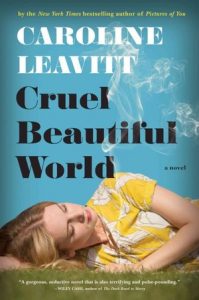Common Writing Mistakes: A Beginner’s Course
Just starting out writing? Want to make sure your work shines enough to grow a career? Here are some tips.
 To Market to Market, and Why You Should Not Write For It
To Market to Market, and Why You Should Not Write For It
I know, I know. You go to a bookstore or read the bestseller lists and it seems like every novel has the word “Girl” in it or is a racy thriller with an unreliable narrator. You may think that’s the kind of book you should read, but please don’t. When you write to the market, to what you think people are going to clamor to read, you lose what is most special and unique to you personally. So what do you do instead?
Think about the questions that are haunting you. For me it was “Can you ever know the one you love?” (Pictures of You.) “Can an outsider ever belong to a community that doesn’t want her? (Is This Tomorrow) and most recently, “Are there really some things in life that you cannot fix and you just have to step away from them? (Cruel Beautiful World).
I didn’t know the answers to any of those questions when I began writing those novels, but as I wrote, the answers began to appear, and because they were so important to me, they actually became important to others—enough so that Pictures of You and Is This Tomorrow hit the NYT Bestseller list.
So think about writing the book that is going to change YOUR life, and I guarantee it will change someone else’s. Your job is to create art.
Going too Fast at the Starting Gate
I read and critique manuscripts for part of my living, and one of the most common errors I see is writers start their stories too soon. They take pages to set things up, when what you want to do is jump into the middle of the conflict, show us a character with a real dilemma, and a real moral choice to make. For example, say you are writing about a woman whose estranged, nasty mother has dementia and she has to come home and take care of her.
If you start with a description of the house, readers are going to be checking their watch. If you start with the woman telling the story of how she was born and what kind of childhood she had, readers are going to wonder what they reading and why. Instead, consider starting in the conflict. The woman is up for a promotion but she has to work extra hard and then she’s called home to be with the mother she’s never gotten along with. Instantly we think, uh oh, what is she going to do?
There’s a big difference between a laundry list and a story. Look at this: Mary went to the store. She bought a cake. She came home and made one out of chocolate and threw in some figs. Are you thinking, what’s going to happen next? No, right? That’s because story is not “this happened, then this happened, then this happened.” Instead, it’s more like this: because this happened, that had to happen, and because that happened, this next thing had to happen.
So the Mary story might look like this now: Desperate for the cash that winning the Bake-off would get her, Mary ran to the store for cake ingredients. She rushed home to make the cake because the deadline was today, the same deadline for the rent money she didn’t have, and because she knew the contest liked the unusual, she threw some figs into the chocolate batter.
See the difference?
You want readers, agents, and editors, to instantly be hooked, because often they won’t read past the first ten pages. They need to know what is the question your book is asking? Who is the main character and what kind of trouble is that character in?
Look at the difference between these first two sentences and you’ll see what I mean.
The yard was strewn with leaves, as golden as Betsy’s hair, as soft as the kitten that lolled in the front yard.
It was a Thursday when Betsy ran away.
Which sentence makes you want to ask more questions? The second one, right? You want to know why she ran away, where she’s going, what she is going to do when she gets there. The first sentence just makes you yawn.
And finally. Never Ever Give Up
Writers hear a lot of “nos.” And a lot of “maybes.” I collected enough rejection slips to paper my apartment, and though I’d cry when I  received them, I kept writing until one day, I sold my first story. Remember, a no is often just one person’s opinion. There are story after story about a book that was rejected up to sixty times before it got published—and then went on to become a sensation.
received them, I kept writing until one day, I sold my first story. Remember, a no is often just one person’s opinion. There are story after story about a book that was rejected up to sixty times before it got published—and then went on to become a sensation.
My first novel Meeting Rozzy Halfway was a huge success. But the 7 novels afterwards were failures. I had no publicity, very few reviews. When people asked me what I did, I said, “I’m a writer?” and yes, that question mark was because I didn’t feel like one. My 9th novel, Pictures of You was rejected by my then publisher as not being special enough, and they told me they didn’t want to see any other work from me. I was sure it was over for me. Who would buy a novel from someone who had no sales, who was an unknown after 9 novels?
Algonquin Books did, and they took that “non-special” novel and turned it into a New York Times Bestseller the first month it was out.
You never know what is beyond the next bend, but your job is to keep writing, with purpose, with passion, and perseverance.
—
Caroline Leavitt is the author of the acclaimed Cruel Beautiful World, and the New York Times Bestsellers Is This Tomorrow and Pictures of You. A book critic for the San Francisco Chronicle and People Magazine, she teaches writing online at Stanford and UCLA Extension Writers Program, as well as working with private clients. Visit her at www.carolineleavitt.com
Category: Contemporary Women Writers, How To and Tips































Useful post, It’s best to learn from other’s mistakes than to feel the urge to commit one by oneself & then think of learning. I think we’ve all made some of these mistakes to some degree or another.
Personally, I like the first sentence (with the kitten lolling in the yard) better. 🙂